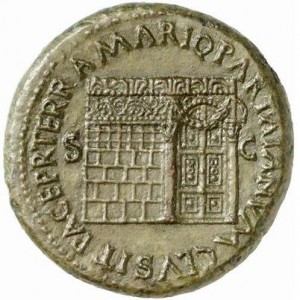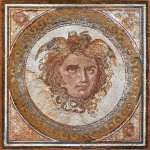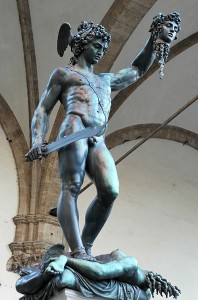In Fasti, Ovid’s poem about the Roman holidays, and consequently of Roman religion, he introduces Janus, or Ianus, the Roman god of doorways and gateways, with:
Two-headed Janus, source of the silently gliding year
Unlike most Roman gods, Janus has no direct Greek precedent. Joseph Campbell suggests that Janus may be rooted instead in the animistic forces of the home or lars.
It doesn’t take my books on symbol, myth, and art history, nor hours of searching through scholarly articles, to see the power of a deity of gateways.
But I looked through them anyway.

And though the basics- gave the name to January, has two faces (sometimes four), beginnings and endings, Roman not Greek- were consistent, Janus turned out to be a somewhat cryptic deity.
Janus tells Ovid he was once called Chaos
This implies that he brings order from that Chaos. In Roman liturgy, he was honored before all other gods. He is the god of all that begins: day, month, or year.
By facing backwards, he holds in his hands the beginning and the ending of all things. Janus is reminder that nothing starts without something else ending, that no door opens unless another is closed.
Encyclopedia Britannica tells us that Rome had many ceremonial gateways with symbolic entrances and exits. The double doors of the Janus Geminus, mentioned in Ovid’s poem, were left open during times of war and closed during times of peace.
Open in war and closed in peace?
No, it doesn’t make much sense, and it’s a point of discussion for scholars. The most credible explanation, from Rabun Taylor, is that Janus read the auspices.

Divination in Rome was based on signs from the gods as to whether an action should be performed or not on a given day. Corresponding to the etymology of the word auspice (which means to look at birds), it was through the flight of birds, and lightning, that the gods spoke most frequently.
Who better to observe the flight of birds than one who can look in both directions?
As Taylor notes, the taking of auspices was almost continuous in time of war, making it necessary to consult the shrine of Janus, the Janus Gemini.
Janus is a liminal deity
A god of transitions, he was consulted before all others precisely because he provides passage to the other gods and to the the omens and signs that allow future action. Taylor notes:
As an arbiter of spatial transitions, Janus was more than a mere gateway. He determined human endeavors as well as space.
At once he looks to the past and to the future- in time, and inward to the home and outward to the other- in space.
His function at the gateway is not to protect, as would an apotropaic figure, like the Medusa. Rather it is to observe and to know. Janus contains within the past and the future, the inside and the outside.
Our calendar starts in January, in midwinter
As Janus tells Ovid:
Midwinter’s the first of the new sun, last of the old
Janus means that beginnings are necessarily born of endings. The year doesn’t start in spring with new growth, trees budding, and birds hatching. The year begins in winter, when it is still cold and nature is dormant.
This choice of new year is not universal. Calendars have been drawn from the sun and from the moon. The start of the year varies from autumn through spring. How we attempt to contain and label time into a calendar speaks of the world that formed our cultures, our religions, and, ultimately, to politics and the pace of an increasingly connected world.
And so the year starts
We’re already entering the second half of the month. New Year’s resolutions lay behind us. Recaps of 2013 are even further in the past. As for me, I didn’t complete my overview. I haven’t set new goals.
But Janus is always present, at the beginning of every day, every week, every month.
So it is always day one, moment one. It is always time to look back. We can erect an imaginary gateway anywhere, a place to look inside and outside. It is always the right time and place to be alert to the signs, to the omens.
We can start every day, everywhere.
In fact, we have no choice but to do so.





